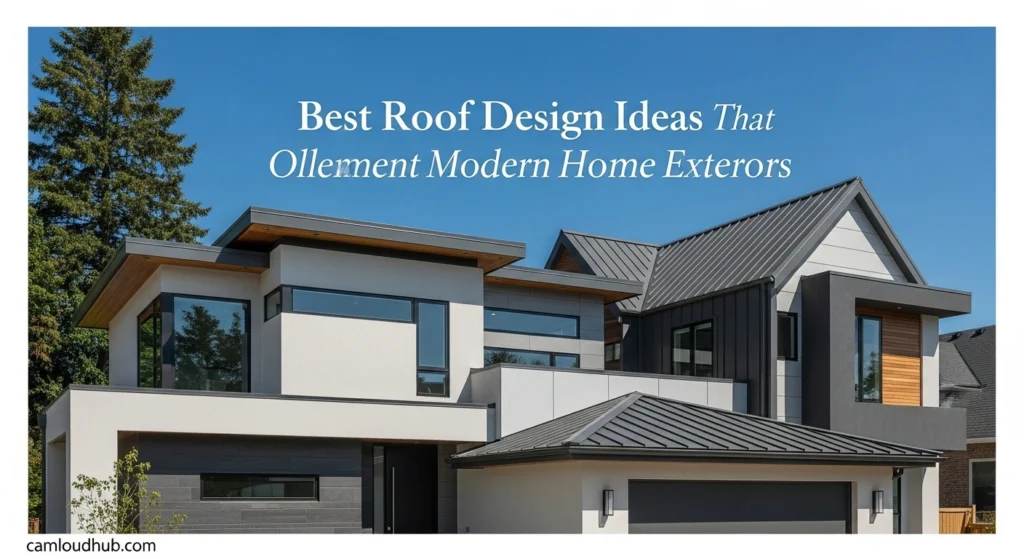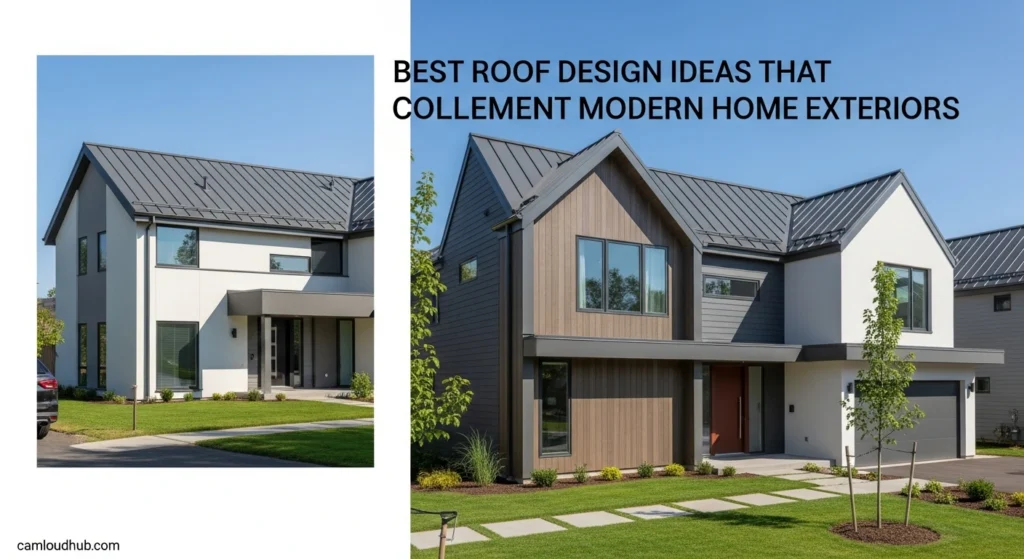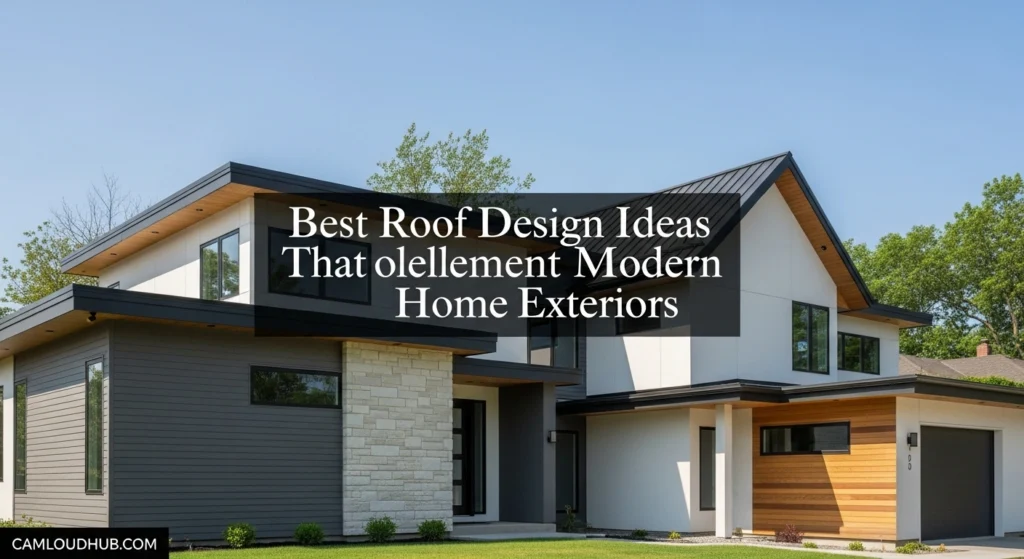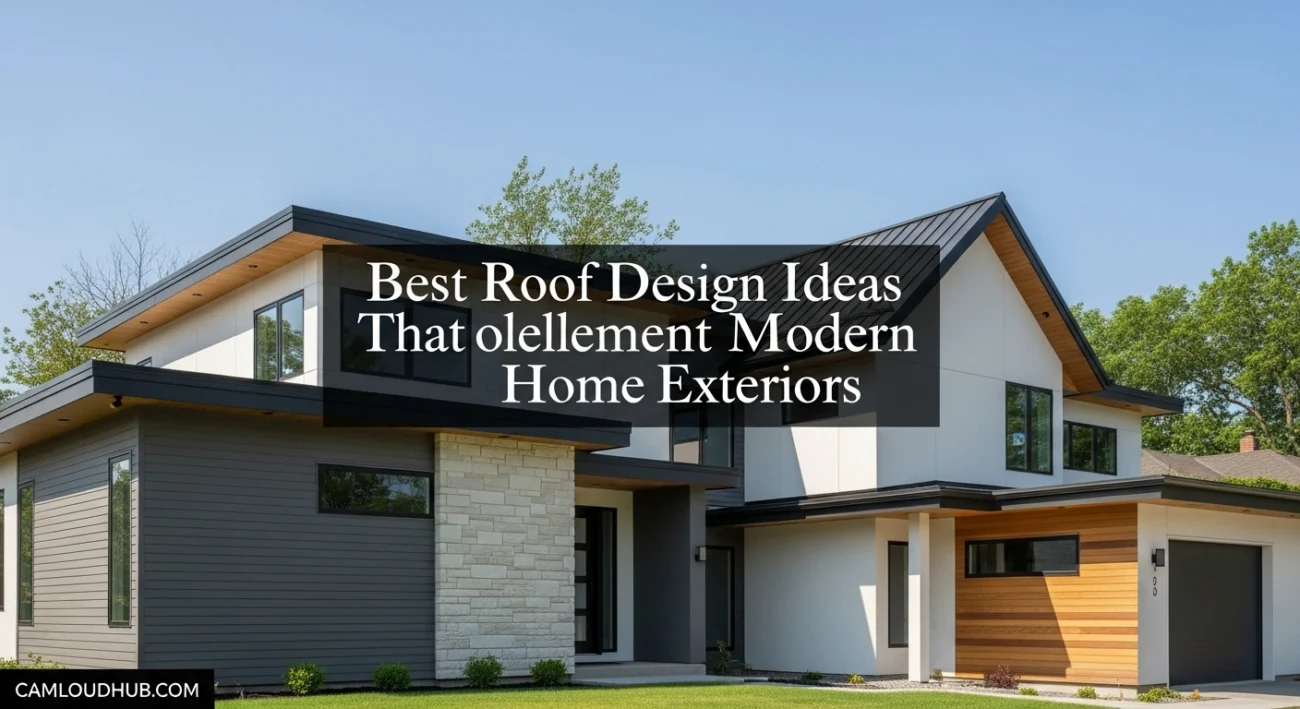Redefining Aesthetics: The Core of Modern Roof Design Ideas
Best Roof Design Ideas That Complement Modern Home Exteriors – Modern architecture celebrates simplicity, functionality, and a seamless connection with the environment. The roof, as the crowning glory of any home, plays a critical role in manifesting these principles. Modern roof design ideas move away from traditional ornate or highly pitched styles, favouring instead clean lines, geometric precision, and often, understated elegance. This shift isn’t just about appearance; it’s about creating a holistic design that enhances living spaces and optimises performance.
The fundamental characteristic of modern roofing is its commitment to sleekness. Flat, low-slope, and geometrically dynamic roofs are hallmarks that visually extend the building’s horizontal planes, contributing to a sense of openness and sophistication. These designs often leverage expansive surfaces to integrate advanced technologies, from solar panels to green landscaping, further blurring the lines between structural necessity and eco-conscious innovation. The interplay of light, shadow, and material composition becomes an art form, making the roof a prime canvas for architectural expression.

Popular Modern Roof Design Ideas for Striking Exteriors
Choosing the right roof design is crucial for achieving a cohesive and impactful modern exterior. Each style offers unique aesthetic and functional advantages, allowing homeowners to tailor their property to their specific vision and needs. Exploring various modern roof design ideas reveals a spectrum of possibilities, from dramatic statements to subtle enhancements, all designed to complement the clean lines and bold forms of contemporary homes.
Whether you’re aiming for minimalist elegance, dramatic flair, or eco-friendly integration, there’s a modern roof type that perfectly aligns with your architectural goals. These popular designs are not just about looks; they are engineered for durability, efficiency, and to enhance the overall living experience, making your home a true beacon of modernity.
Flat & Low-Slope Roofs: The Unassuming Grandeur
Flat roofs might be one of the most iconic modern roof design ideas, embodying the minimalist ethos of contemporary architecture. Despite their name, these roofs aren’t entirely flat; they feature a very low pitch (typically less than 10 degrees) to facilitate water runoff, cleverly concealed to maintain a sleek, uninterrupted horizon line. This design is paramount for creating a clean, geometric silhouette, allowing other architectural elements like large windows and cantilevered sections to truly shine.
The appeal of flat and low-slope roofs lies in their unassuming grandeur. They contribute to a stark, box-like aesthetic that defines many modern homes, providing a strong visual anchor. Functionally, they offer incredible versatility, creating an ideal base for rooftop living spaces, green roofs, or solar panel installations without compromising the exterior’s streamlined appearance. Maintenance and waterproofing are key considerations, but with modern materials and expert installation, they offer long-lasting performance and undeniable style.
Flat and low-slope roofs also open up exciting possibilities for extending usable living space vertically. Many homeowners transform these surfaces into rooftop lounges, outdoor dining areas, or private gardens — effectively adding an entire “room” without expanding the building’s footprint. With the right railing design, weatherproof flooring, and subtle lighting, a flat roof can become an elevated retreat that blends luxury with practicality. This approach perfectly aligns with the principles of modern living: maximizing functionality while preserving simplicity and harmony.
From an energy efficiency standpoint, flat roofs are highly adaptable. They can easily incorporate insulation layers, reflective coatings, or even vegetative (green) systems to help regulate indoor temperatures and reduce energy consumption. The addition of a green roof — whether fully planted or partially covered — enhances biodiversity, improves air quality, and provides excellent thermal and acoustic insulation. These features make flat and low-slope roofs not just architectural statements but environmental assets as well.
In terms of maintenance and longevity, advancements in membrane roofing materials like TPO (thermoplastic polyolefin) and EPDM (ethylene propylene diene monomer) have revolutionized flat roof construction. These durable, UV-resistant materials offer superior waterproofing and minimal upkeep compared to older systems. When properly installed and maintained, a flat or low-slope roof can last for decades while maintaining its crisp, modern look — a perfect balance between design purity and performance.
Butterfly Roofs: Dynamic Symmetry
For those seeking a bolder statement, the butterfly roof stands out as one of the most exciting modern roof design ideas. Named for its resemblance to a butterfly’s wings mid-flight, this roof slopes inward from opposing walls, forming a central valley where rainwater collects and drains. This inverted V-shape creates a dramatic and unique profile that immediately draws the eye, making it a favourite for architects aiming for distinctive, sculptural homes.
Beyond its visual appeal, the butterfly roof offers significant functional advantages. Its inward slope allows for efficient rainwater harvesting, a valuable feature for sustainable living. The higher perimeter walls created by its design can accommodate taller windows, flooding interiors with natural light and offering expansive views while maintaining privacy. Ventilating such a roof system effectively is crucial, but the payoff in terms of architectural impact and potential for natural illumination is immense.
Shed (Skillion) Roofs: Asymmetrical Allure
The shed roof, also known as a skillion roof, offers another compelling option among modern roof design ideas that prioritises both aesthetics and functionality. Characterised by a single, continuous slope, a shed roof is essentially half of a gable roof, lending itself to dynamic, asymmetrical compositions. This design can dramatically vary in pitch and direction, creating interesting geometric interplay with the home’s other facets.
Shed roofs are highly versatile, often used to create varied ceiling heights within the home – a high side for spacious communal areas and a lower side for more intimate rooms. This allows for strategic placement of clerestory windows on the taller wall, maximising natural light and enhancing ventilation. Their single-slope nature is also excellent for efficient rainwater runoff and ideal for optimising solar panel placement, making them a practical and visually engaging choice for modern homes.
Beyond Aesthetics: Functional & Sustainable Modern Roof Design Ideas
Modern home design is not just about looking good; it’s about performing better. The evolution of modern roof design ideas reflects this commitment to sustainability, efficiency, and incorporating technology to enhance the living environment. These innovative roofing solutions go beyond traditional weather protection, actively contributing to the home’s energy performance, ecological footprint, and even the well-being of its occupants.
Integrating functional and sustainable elements into your roof design is a smart investment that pays dividends in comfort, cost savings, and environmental responsibility. From harnessing the power of the sun to cultivating vibrant ecosystems, these modern approaches transform the roof into an active participant in your home’s overall efficiency and aesthetic appeal.

Green Roofs: Blending Nature and Architecture
Green roofs represent one of the most environmentally forward-thinking modern roof design ideas, transforming otherwise unused roof space into vibrant ecosystems. These living roofs involve a layer of vegetation planted over a waterproofing membrane, creating a natural oasis above your home. They excel at blending architecture with nature, softening the typically stark lines of modern design with lush, natural beauty.
The benefits of green roofs are extensive. They significantly improve stormwater management by absorbing rainfall, reducing runoff into drainage systems. They act as natural insulators, keeping homes cooler in summer and warmer in winter, thus reducing energy consumption. Furthermore, green roofs combat the urban heat island effect, improve air quality, provide habitat for wildlife, and even offer tranquil rooftop gardens for relaxation. While requiring careful structural assessment and maintenance, their ecological contributions and stunning visual appeal make them an increasingly popular choice for sustainable modern homes.
Solar-Integrated Roofs: Powering the Future
Harnessing solar power has moved beyond cumbersome panels bolted onto existing roofs. Today, solar-integrated roofs are among the most practical and aesthetically pleasing modern roof design ideas for energy independence. These systems seamlessly incorporate photovoltaic (PV) technology directly into the roofing materials themselves, creating a cohesive and visually appealing façade that generates clean energy.
The beauty of solar-integrated roofs lies in their dual function: they protect your home and power it simultaneously, without the chunky appearance of traditional solar arrays. This approach maintains the clean lines and minimalist aesthetic cherished in modern architecture, making sustainability an inherent part of the design rather than an add-on. Investing in solar integration not only reduces your carbon footprint but also significantly lowers utility bills, making it an economically smart choice for the future-savvy homeowner.
In addition to their aesthetic and environmental advantages, solar-integrated roofs are engineered for exceptional durability and weather resistance. The photovoltaic shingles or tiles are designed to withstand extreme temperatures, heavy rainfall, and even hail — all while maintaining their efficiency and sleek appearance. Many modern systems come with smart monitoring features that allow homeowners to track energy production in real time via mobile apps, making energy management both transparent and intuitive.
Another major advantage lies in their compatibility with battery storage systems. When paired with home energy storage, excess electricity generated during the day can be stored and used at night or during power outages. This combination enhances a home’s resilience and self-sufficiency, turning it into a micro power station that can operate independently of the grid. As energy costs continue to rise, this level of autonomy becomes increasingly valuable.
Finally, solar-integrated roofs contribute to a home’s overall property value and sustainability certification. Homes equipped with integrated solar systems are not only more attractive to eco-conscious buyers but also often qualify for tax incentives, green building credits, and lower insurance premiums. The seamless blend of form, function, and future-focused technology makes solar-integrated roofing one of the most forward-thinking investments in modern home design — a true symbol of sustainable luxury.
Integrated Photovoltaic (BIPV) Systems
Building-Integrated Photovoltaic (BIPV) systems are at the forefront of seamless solar integration, making them a standout among modern roof design ideas for their discretion and efficiency. These systems are designed to be an integral part of the building’s envelope, replacing conventional roofing materials rather than being mounted on top of them. BIPV panels mimic the appearance of traditional shingles, tiles, or membrane roofing, providing both weather protection and electricity generation.
The primary advantage of BIPV is its aesthetic elegance. It allows for architects and homeowners to maintain the sleek, uninterrupted lines characteristic of modern design, as the solar cells are virtually indistinguishable from regular roofing components. This harmonious integration means no unsightly racks or gaps, just a clean, uniform surface that quietly generates power. While the initial investment might be higher, the long-term energy savings and enhanced curb appeal make BIPV an increasingly attractive option for truly modern, sustainable homes.
Solar Shingles & Tiles
Taking the concept of BIPV a step further, solar shingles and tiles offer an even more refined approach to energy generation, solidifying their place among the most advanced modern roof design ideas. These innovative products are designed to look exactly like conventional asphalt shingles, clay tiles, or slate, but they contain embedded photovoltaic cells capable of converting sunlight into electricity. They are installed piece by piece, just like traditional roofing, integrating flawlessly into the roof’s overall texture and colour.
The discreet nature of solar shingles and tiles makes them ideal for homeowners who desire renewable energy without compromising their home’s architectural integrity or aesthetic vision. They offer excellent weather protection alongside power generation, making your roof a hardworking, dual-purpose element. This technology is continually advancing, offering greater efficiency and a broader range of styles, proving that highly functional, sustainable design can also be utterly beautiful.
Choosing Your Perfect Modern Roof Design
Selecting the ideal modern roof design for your home is a decision that balances aesthetic ambitions with practical considerations. It’s an opportunity to solidify your home’s architectural identity while optimising its performance and sustainability. With a myriad of innovative modern roof design ideas available, navigating the choices requires thoughtful consideration of several key factors that will ensure your investment is both stunning and sensible.
The journey to your perfect modern roof involves more than just picking a style; it’s about understanding how that style interacts with your specific environment, budget, and long-term goals. Making an informed decision will not only enhance your home’s curb appeal but also contribute significantly to its efficiency, durability, and overall value for years to come.

When embarking on this crucial decision, consider the following:
- Architectural Style and Harmony: The most fundamental aspect is ensuring the roof design complements the overall architectural style of your home. A sleek, low-slope roof might be perfect for a minimalist box-style house, while a dramatic butterfly roof could elevate a more sculptural design. The roof should enhance, not detract from, the existing or planned aesthetic.
- Climate and Environmental Conditions: Your local climate plays a significant role in determining the most suitable roof design and materials.
- Rainfall and Snow Load: Higher pitched roofs (like shed roofs) excel at shedding heavy rain and snow. While flat roofs manage water effectively with proper drainage, they require rigorous waterproofing and less pitch variations for heavy snow loads usually.
- Sun Exposure: For solar integration, southern exposure is crucial. Green roofs can help cool homes in hot climates.
- Wind Resistance: Certain designs and materials may offer better wind resistance in high-wind zones.
- Budget Considerations: Modern roof design ideas vary widely in cost, influenced by complexity, materials, and installation requirements.
- Initial Investment: Flat roofs might seem simpler, but their advanced waterproofing systems can be costly. Butterfly roofs require complex structural engineering. Green roofs have higher initial material and installation costs.
- Long-Term Costs: Factor in maintenance, energy savings (from solar or green roofs), and potential longevity. A higher initial investment in a durable, energy-efficient roof can lead to significant savings over time.
- Materials and Longevity: The choice of roofing material significantly impacts both the appearance and lifespan of your modern roof.
- Membrane Roofing (TPO, EPDM, PVC): Common for flat and low-slope roofs, known for durability and waterproofing.
- Metal Roofing (Standing Seam, Corrugated): Offers a sleek, industrial look, excellent longevity, and suitable for low slopes. Often a great base for solar integration.
- Concrete or Clay Tiles: Can be adapted for modern aesthetics with specific profiles, offering durability.
- Sedum Mats or Specific Plant Varieties: For green roofs, requiring careful selection for climate suitability.
- Sustainability Goals: If environmental responsibility is a priority, consider modern roof design ideas that incorporate green technologies.
- Energy Efficiency: Solar-integrated roofs directly generate power, while green roofs provide natural insulation.
- Water Management: Butterfly and green roofs excel at rainwater harvesting and stormwater reduction.
- Material Sourcing: Look for recycled content, locally sourced materials, and products with a low environmental impact.
- Maintenance Requirements: Different roof types necessitate varying levels of maintenance. Flat roofs require regular inspection of drains and membranes, while green roofs need vegetation care. Consider your willingness and ability to commit to ongoing maintenance.
- Local Building Codes and Regulations: Always check with local authorities for specific building codes, zoning restrictions, and homeowner association (HOA) guidelines that might influence your roof design choices. These regulations can impact everything from roof pitch to material selection.
- Expert Consultation: Engaging experienced architects, contractors, and roofing specialists is invaluable. They can provide tailored advice, ensure structural integrity, and navigate complex installations, transforming your chosen modern roof design ideas into a practical, beautiful reality.
By carefully evaluating these points, you can confidently select a modern roof design that not only complements your home’s exterior but also meets your functional needs, sustainability aspirations, and budgetary constraints, creating a truly integrated and impressive modern residence.
Conclusion: Elevating Your Home with Modern Roof Design Ideas
The roof of your modern home is an architectural triumph waiting to happen. Far from being a mere cover, it stands as a testament to contemporary design principles, blending innovative aesthetics with unparalleled functionality and sustainability. Embracing the diverse range of modern roof design ideas means choosing to make a powerful statement about your vision for cutting-edge living.
Whether it’s the minimalist elegance of a flat roof, the dramatic sculptural quality of a butterfly design, the dynamic asymmetry of a shed roof, or the eco-conscious integration of green and solar roofs, each option offers a unique path to enhancing your home’s exterior. These modern masterpieces are engineered not just to protect but to transform, inviting natural light, optimising energy efficiency, and creating stunning visual dialogues with the surrounding landscape. Invest in a roof that truly crowns your modern home – a design that speaks volumes about style, innovation, and a sustainable future.


